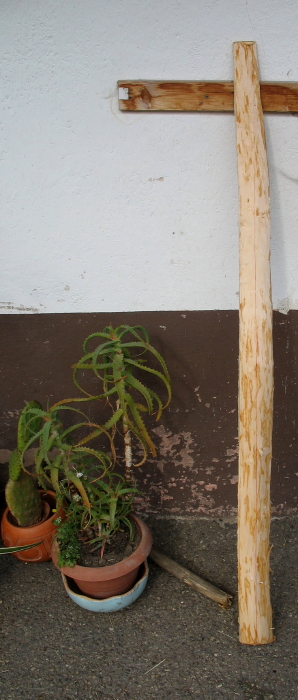O.k., first article 2011. It´s a “to be continued” of “Bow- staves- Vol.2- making a bow from green wood”
The mentioned rowan- bow is ready, but to far away from 50lbs at 23″: 27lbs at 23″, what´s wrong about it? I did the bow to thin! That´s all, cause of my lack of experience in making bows of rowan- saplings. To fail is the teacher you´ll never forget.
Anyway I heat- treated much more reflex into the bow, I didn´t succeed in increasing the drawweight: if there is to less material, it is a no- go to enforce a selfbow. It´s quite better to cut away to less wood 20 times than to cut to much wood away one time! It´s not possible to add wood to a selfbow. Usually I keep such a failed bow, sooner or later a customer will ask for it.
The bow was tested, 27lbs at 23″, I did no chronos, it shoots a 350grs.- arrow at about 130yards.


Beside the failed drawweight the bow is matching my expectations. I want the slightly reflexed limbs to become straight when drawn, most working is just beside the handle, so there is a quite well energy- storage.
This bow is a kind of study for to more get confident with the deflex/reflex- design I´m actually studying.
The second trial with a rowan- sapling:

What looks straight is a bit snaky and twisty too, but with someheat-treating I could get by with it.

Cause the stave is green, it´s really easy to straighten it finally, but there´ll remain some tracks of its naturally growing- pattern. That´s what makes selfbows such distinctively genuine.

The handle is almost completely beside the center- line. Laying out the handle and the skinny tips. I wanted to make a longer handle as usual for to shorten the working area of the limbs. Combined with the skinny tips, this is a way for to mix the qualities of a longer bow with the capablities of a shorter bow: good leverage and a quick movement of the limbs.

My Swedish ax is one of the best tools I´ve ever bought, this blacksmith is making single pieces, just tell him what you want. The most important thing is a premium blade, highly durable and not to heavy. If an ax is to heavy, it is not possible to make exactly cuts and your hands will be tired soon.





Next volume will be focused on making a jig for drying a greenwood- bow, it could also be used for heat- treating.
Related Articles
- Bow staves Vol. 1- harvesting rowan and whitebeam (redhawk55.wordpress.com)
- Bow staves Vol. 2- making bows of green wood (redhawk55.wordpress.com)
- bow staves Vol.3- chosing, splitting, ……….picture heavy! (redhawk55.wordpress.com)





























